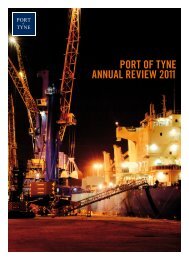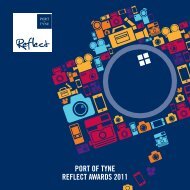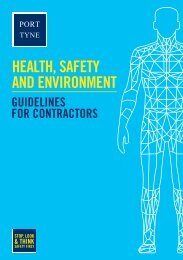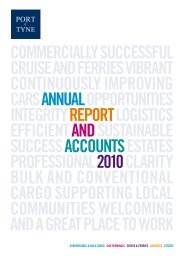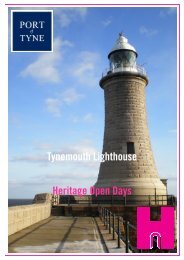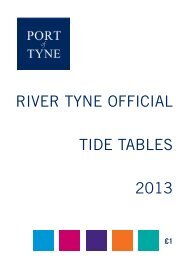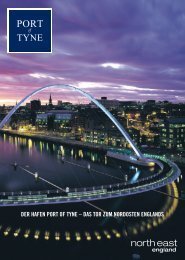PORT OF TYNE ANNUAL REPORT AND ACCOUNTS 2011
PORT OF TYNE ANNUAL REPORT AND ACCOUNTS 2011
PORT OF TYNE ANNUAL REPORT AND ACCOUNTS 2011
Create successful ePaper yourself
Turn your PDF publications into a flip-book with our unique Google optimized e-Paper software.
08/<strong>ANNUAL</strong> RE<strong>PORT</strong> <strong>AND</strong> <strong>ACCOUNTS</strong> <strong>2011</strong><br />
CHIEF EXECUTIVE <strong>OF</strong>FICER’S STATEMENT/09<br />
STATEMENT BY THE CHIEF EXECUTIVE <strong>OF</strong>FICER<br />
CONTINUED...<br />
Economic ImpacT<br />
The impact of the Port of Tyne on the<br />
regional economy is measured on an<br />
annual basis through an Economic Impact<br />
Assessment. External consultants ARUP<br />
have reported that the Gross Value Added<br />
(GVA) by the Port of Tyne to the regional<br />
economy has increased by 11% to £467<br />
million (2010 – £421 million). Included in<br />
this is the significant impact of £45 million<br />
in tourist spend resulting from passengers<br />
using the Port’s International Passenger<br />
Terminal that facilitates the DFDS Newcastle<br />
to Amsterdam ferry service and the<br />
developing cruise business. The report<br />
also highlights that the Port supports 9,425<br />
(2010 – 8,836) full time port related jobs<br />
in the wider community, including those<br />
directly employed.<br />
Stakeholder Benefit<br />
Stakeholder Benefit delivered during<br />
<strong>2011</strong> also increased significantly by 24%<br />
to £8.3 million (2010 – £6.7 million),<br />
comprising of taxation, direct investment<br />
and ‘in kind’ support.<br />
£7.6 million was generated in tax receipts<br />
for the Government and charged against<br />
income in the year, relating to employee<br />
taxation, company taxation and business<br />
rates (2010 – £6 million).<br />
Investments in stakeholder benefit which<br />
are included in operating profit within<br />
the Port’s financial statements amounted<br />
to £0.7 million (2010 – £0.6 million).<br />
The principal components of this were:<br />
– £224k (2010 – £212k) was invested in the<br />
business’s employee Profit Share Scheme,<br />
now in its second year of operation<br />
– The costs of operating and maintaining<br />
the Swing Bridge, a scheduled monument,<br />
of £166k (2010 – £138k), which is<br />
not a commercially viable asset on<br />
a stand-alone basis<br />
– The Port actively supports its regional<br />
and national business partners,<br />
through subscription and membership<br />
of organisations that include the CBI<br />
Regional Council, the North East<br />
Chamber of Commerce, the EEF Regional<br />
Council, Business in the Community,<br />
the NewcastleGateshead Initiative and<br />
the Institute of Directors. During the<br />
year it invested £139k (2010 – £127k)<br />
in these activities<br />
– £94k (2010 – £116k) has been expended<br />
in sponsorship of events and activities in<br />
support of developing the local community<br />
such as the Mouth of the Tyne Festival,<br />
the Tyne Tunnel 2k wheelchair event, the<br />
Pride of South Tyneside Awards and<br />
supporting the Port’s Writer in Residence<br />
programme and the annual ‘Reflect’<br />
photography and film Awards<br />
– £30k (2010 – £30k) donation to the Port<br />
of Tyne charitable fund, administered by<br />
the Community Foundation and a £50k<br />
donation to the Nissan President Fund<br />
in the wake of the Japanese tsunami in<br />
March <strong>2011</strong><br />
– £10k (2010 – £10k) rental support to<br />
the North Shields Fish Quay Company<br />
‘In kind’ services were provided amounting<br />
to £17k. (2010 – £29k) ‘In kind’ activity<br />
relates to the continued waiving of<br />
conservancy charges to Royal Navy vessels<br />
that are open to the public.<br />
Health and Safety<br />
The Port previously set the target of<br />
achieving the internationally recognised<br />
Health and Safety standard OHSAS 18001<br />
certification. This has resulted in further<br />
emphasis being placed on the awareness<br />
of health and safety issues, reporting,<br />
incident investigations and training.<br />
The business was successful in<br />
achieving OHSAS 18001 certification<br />
in February 2012.<br />
An improvement in the level of near miss<br />
reporting has contributed to the increase<br />
in the number of incidents recorded in<br />
<strong>2011</strong>, up 50% to 891. ‘Near miss’ reporting<br />
has risen to 55% in <strong>2011</strong>, having risen<br />
from 38% in 2010.<br />
Whilst the number of injuries recorded in<br />
<strong>2011</strong> at 69 was 18% lower than in 2010,<br />
the related number of working days lost<br />
at 168 was 47% greater than in the<br />
previous year. This is reflected in the rise<br />
in reportable injuries to the Health and<br />
Safety Executive (HSE) or the Marine and<br />
Coastguard Agency (MCA), required when<br />
the associated lost number of working days<br />
is in excess of three, which has increased<br />
from 3 to 10.<br />
Port Marine Safety Code<br />
As part of the business’s drive to improve<br />
Health and Safety standards, the Port has<br />
also adopted the guidelines within the Port<br />
Marine Safety Code. This code has been<br />
developed to improve safety in UK ports<br />
and to enable harbour authorities, of which<br />
the Port of Tyne is one, to manage marine<br />
operations to nationally agreed standards.<br />
It provides the standard against which the<br />
policies, procedures and the performance<br />
of harbour authorities can be measured.<br />
The Code describes the role of Board<br />
members, officers and key personnel in<br />
relation to safety and navigation, and<br />
summarises the main statutory duties<br />
and powers of harbour authorities. It also<br />
requires an effective marine Safety<br />
Management System be adopted based<br />
on formal risk assessment.<br />
The Port of Tyne’s compliance with the<br />
Code is assured by the operation and audit,<br />
both internal and external, of the Port’s<br />
marine Safety Management System.<br />
In response to a request from the Maritime<br />
and Coastguard Agency (MCA) regarding<br />
Code compliance, the Board of the Port of<br />
Tyne has advised, in a letter dated 2 March<br />
2012, that it has implemented a range of<br />
procedures designed to ensure compliance<br />
with the provisions of the Code.<br />
Environment<br />
The Port achieved ISO 14001 certification<br />
during the second half of 2010 and has<br />
maintained this during <strong>2011</strong>. The<br />
certification demonstrates compliance<br />
with relevant environmental legislation,<br />
a commitment to the prevention of<br />
pollution and the implementation of a<br />
programme of continual improvement<br />
and environmental monitoring.<br />
Conscious of the potential impact of<br />
operations on local residents, the Port<br />
commissioned two studies; one to assess<br />
any impact of noise and possible solutions<br />
and the other to identify any sources of<br />
dust that may arise from Port operations<br />
and identify potential solutions.<br />
Extensive audit and engagement with<br />
employees, customers, tenants and<br />
contractors have been undertaken across<br />
the year to ensure that the rigorous<br />
standards of ISO 14001 have been<br />
maintained.<br />
Research commissioned in 2010 by the<br />
Port of Tyne and its partners, ONE North<br />
East, the Environment Agency, Newcastle<br />
City Council and North Tyneside Council<br />
into the quality and flow of sediment within<br />
the River Tyne estuary, indicated that as<br />
well as localised contaminated sediments<br />
associated with specific river bank<br />
industries being evident, other material<br />
emanating from former mine working in the<br />
upper reaches of the South Tyne are also<br />
present within the river system. A second<br />
phase of the study commenced in late<br />
<strong>2011</strong> to examine in detail the options and<br />
solutions available to address the issues,<br />
the findings of which are planned to be<br />
available in 2012. In addition to the phase<br />
one funding partners, financial support<br />
for the second phase has also been<br />
provided by South Tyneside Council,<br />
Gateshead Council and Northumberland<br />
County Council.<br />
Customer Focus<br />
Business Development<br />
This review of business development<br />
demonstrates how the Port has embedded<br />
its value of Customer Focus across the<br />
business in <strong>2011</strong>.<br />
Developments in the energy sector remain<br />
central to the development of the Port’s<br />
business. In the first full year of handling<br />
wood pellet in partnership with Drax Power,<br />
cumulatively almost one million tonnes of<br />
wood pellets were handled. This resulted<br />
from a 10 year agreement with Drax Power<br />
and the subsequent investment by the<br />
Port in dedicated handling, storage and<br />
associated infrastructure to accommodate<br />
this new cargo. <strong>2011</strong> saw the additional<br />
investment of £2.2 million in two purposedesigned<br />
mobile hoppers to handle wood<br />
pellets, taking the total investment in this<br />
new area of business to in excess of<br />
£20 million.<br />
As part of this programme of investment,<br />
the Port completed the most extensive<br />
dredge of the river in the last 50 years<br />
increasing the channel depth to a record<br />
of 10 metres, and a record 13 metres at<br />
its main Riverside Quay berth. The Tyne<br />
is now deeper than ever before, enabling<br />
the Port to accept 83% of the world’s bulk<br />
carrier fleet.<br />
This development also assisted in driving<br />
up coal import volumes which increased<br />
by 175% in the year to 2.1 million tonnes.<br />
To support the business’s dredging<br />
operations the Port has procured a ‘plough<br />
dredger’ named the ‘Sir Bobby Robson’,<br />
which arrived for trials and crew training<br />
in December <strong>2011</strong>. It is a replacement<br />
for the ‘grab dredger’, the ‘Hedwin’, which<br />
was decommissioned after almost 50<br />
years of service.<br />
Rail connectivity is fundamental to the<br />
Port’s multi-modal offering and is key in<br />
enabling the transportation of coal and<br />
wood pellet cargoes to the locations of<br />
power generating customers. During the<br />
year additional rail capacity was created<br />
by the re-opening of the section of line<br />
known as the Boldon East Curve, which<br />
enabled traffic leaving the Port to be routed<br />
in an easterly direction before joining the<br />
East Coast Main Line at Northallerton.



